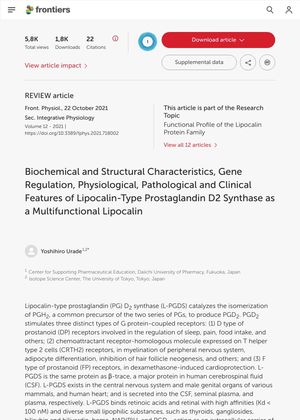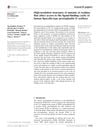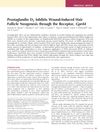Biochemical and Structural Characteristics, Gene Regulation, Physiological, Pathological and Clinical Features of Lipocalin-Type Prostaglandin D2 Synthase as a Multifunctional Lipocalin
October 2021
in “
Frontiers in Physiology
”
Lipocalin-Type Prostaglandin D2 Synthase L-PGDS prostaglandin D2 PGD2 hair follicle neogenesis retinoids thyroid hormones glucose transport adipose tissues mast cells neuroprotection apoptotic loss lysosomal storage disorders adipocyte differentiation insulin resistance wound-induced hair follicle neogenesis renal fibrosis sex organ development embryonic germ cells systemic lupus erythematosus mucopolysaccharidosis type II osteoarthritis inflammation azoospermia hair follicle formation fat tissues nerve protection cell death fat cell differentiation kidney fibrosis germ cells lupus MPS II joint inflammation low sperm count

TLDR Lipocalin-Type Prostaglandin D2 Synthase (L-PGDS) is a protein that plays many roles in the body, including sleep regulation, pain management, food intake, and protection against harmful substances. It also affects fat metabolism, glucose intolerance, cell maturation, and is involved in various diseases like diabetes, cancer, and arthritis. It can influence sex organ development and embryonic cell differentiation, and its levels can be used as a diagnostic marker for certain conditions.
The document discusses the multifunctional role of Lipocalin-Type Prostaglandin D2 Synthase (L-PGDS), a protein involved in various physiological and pathological processes. L-PGDS catalyzes the production of prostaglandin D2 (PGD2), which plays roles in sleep regulation, pain management, food intake, and inhibits hair follicle neogenesis. L-PGDS also acts as an extracellular transporter of retinoids and thyroid hormones, binds to harmful substances, and plays a protective role in various physiological and pathological processes. It is involved in glucose transport in muscle and adipose tissues, affecting fat metabolism and managing glucose intolerance associated with type 2 diabetes. L-PGDS also influences the maturation of mast cells, plays a role in cancer cells, and is involved in pain and sleep regulation. It plays a crucial role in sleep regulation, with its absence leading to insomnia in certain knockout mice. L-PGDS also protects neurons and glial cells from apoptotic loss, is involved in the pathology of several lysosomal storage disorders, and plays a role in neuroprotection against stress conditions and recovery from brain damage. It regulates food intake, plays a crucial role in the maintenance of the peripheral nervous system, and is involved in obesity and adipocyte differentiation. L-PGDS also regulates body weight gain and insulin resistance under nutrient-dense conditions, plays an anti-inflammatory role in arthritis, inhibits wound-induced hair follicle neogenesis, contributes to the progression of renal fibrosis, and is involved in preterm birth. It plays a crucial role in sex organ development, with its absence leading to malfunctions in both male and female genital organs and intergenerational subfertility. It also influences the differentiation of embryonic germ cells. A study with 121 type-2 diabetes patients showed that urinary L-PGDS levels can predict future renal injury. L-PGDS levels are also found to increase in patients with systemic lupus erythematosus and decrease in patients with mucopolysaccharidosis type II disease. The expression of L-PGDS varies among different types of cancers and is induced in cartilages of patients with osteoarthritis. It is also involved in inflammation of the digestive tract and acts as an inflammatory marker. In reproduction, L-PGDS levels are higher in the umbilical cord blood and amniotic fluid newborn urine than the maternal blood, and are a potential diagnostic marker for preeclampsia. Lower L-PGDS levels are found in patients with azoospermia.





